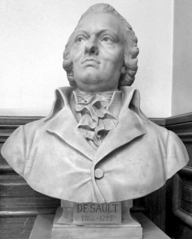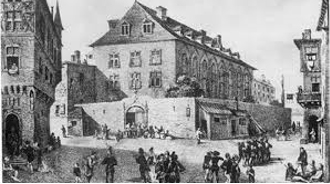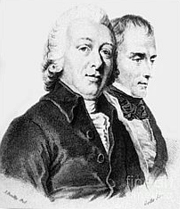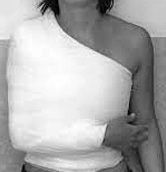|
||||||||||||||||||||||||||||||||||||
| [
Contents
] [ INDEX ]
|
||||||||||||||||||||||||||||||||||||
|
Page 141 |
||||||||||||||||||||||||||||||||||||
|
History of medicine Pierre-Joseph Desault, 1744-1795 Slađana Matić (1,2), Dragana Vučković (1), Ivana Glišović-Jovanović (1), Stefan Korica (1), Marko Simić (1), Katarina Gambiroža (1), Mihailo Ille (1,2) (1) CLINICAL CENTER OF SERBIA, CLINIC FOR ORTHOPEDIC SURGERY AND TRAUMATOLOGY, PASTEROVA 2, BELGRADE, SERBIA; (2) FACULTY OF MEDICINE, UNIVERSITY OF BELGRADE, DR SUBOTIĆA 8, BELGRADE, SERBIA |
||||||||||||||||||||||||||||||||||||
|
|
||||||||||||||||||||||||||||||||||||
| Download in pdf format | Abstract:
Pierre-Joseph Desault (1744-1795) was the first French professor of
clinical surgery. The clinical school of surgery which he instituted
at the hospital Hôtel-Dieu attracted great numbers of students from
France and other countries. In 1791 he established a Journal de
chirurgerie, a record of the most interesting clinical cases. He
introduced many improvements to surgical practice and construction
of surgical instruments. Desault published his work rarely, but his
students later did, based upon his lectures. He was teaching surgery
in an innovative way, in French, with a lot of demonstration and
practice. Therefore, he is rightly considered a forerunner of modern
medical teaching. Although primarily a surgeon, Desault practically
signed the birth certificate of nephrology by clinical observation,
and is considered, together with Chopart, a pioneer of urology. His
influence on the development of medical science in France is great,
but his ability to organize the hospital and his exceptional
pedagogical activities are especially emphasized. Key words: Pierre-Joseph Desault, hospital Hôtel-Dieu, French surgery |
|||||||||||||||||||||||||||||||||||
|
French anatomist and distinguished surgeon, was born at village
Magny-Vernois, a small place near Lure, in 1738 on February the 6th
[1], although different data about his birth year can be seen on a
bust near University of Medicine (figure 1). There are various
opinions about how his surname is spelled and written, because in
official documents we can find surnames as “Dusaut”, “de Sault” or
“Dessault” [2]. As it is mentioned in a thesis by Saison, his
surname was repeatedly confused with a name of physician Pierre
Desault, who lived in a city of Bordeaux (1675-1737). Desault's
nephew claimed that Desault was pronounced nobleman by king Louis
XVI, and received a coat of arms, which couldn’t been verified in
official documents[2]. Figure 1. Desault's bust
He came from a humble family and was supposed to be a priest.
Because of his poverty, he was educated by the Jesuits. However, he
early decided to study medicine. He was the scholar of a local
barber-surgeon. He acquired some knowledge about anatomy and
military surgery in the military hospital of Belfort. He collected
and wrote medical information about the wounded he was taking care
of. As it was cited later by Marie François Xavier Bichat
(1771-1802), the reader of this records would have an impression
that Desault was a very experienced surgeon. His favorite studies
were anatomy and mathematics, and he applied mathematical principles
to his anatomical investigations. Desault translated Borelli's „De
Motu Animalium” with notes and illustrations. Figure 2. Hospital Hôtel-Dieu
Desault was spending most of his time in Hôtel-Dieu hospital. He
organized rounds, took care of patients, operated in front of
students and performed autopsies. He held lectures regularly,
evaluated students’ knowledge and followed their work with patients.
His lecturing program was consisted of anatomy, operative practice
and clinical knowledge, which he considered the base element of
their education. The lectures were performed in French, not in
Latin, and they were both verbal and practical. Between 1780 and
1781 in Paris, student Louis-Marie Lavergne (1756-1831), from
Breton, wrote Desault's anatomy lectures in form of a manuscript in
23 volumes. These were preserved by his descendant, doctor Roüault
de La Vigne from Rennes. The way of expression in these manuscripts
is mostly descriptive. Figure 3. Desault and his pupil Bichat
Desault welcomed him into his home and entrusted him with part of
his obligations, especially private practice[1]. Two years after
Desault’s death, in 1797, he abandoned surgical practice and became
a physiologist. Desault’s work would be vanished from the history of
medicine, if it wasn't for Bichat, who consolidated all of his
lessons from surgical journals and published them as books. He
published Desault’s surgical doctrines in O'Euvres chirurgicales de
Desault (1798-1799). Later, he wrote a treatise on surgical
operations in three volumes and treatise of fractures and
dislocations, which was translated to English in 1805, and went
through three American editions. Figure 4. Desault bandage
Both Desault's clinical dedication and observation cleared the
path toward new field in medicine, the field of nephrology [1]. He
observed his findings as a pathophysiologist and he recognized
polyuria (or diabetes as it was called at that time), which is the
consequence of disorders of the body fluids, and also disorders of
the kidney. He noticed that the first type was painless, preceded by
thirst, dry skin and the signs of dehydration, and indicated a
metabolic disorder without problems in kidney functioning. The other
one was the consequence of inflammation or destruction of the
kidney`s parts, or the kidney in general. He defined suppression or
retention of urine as a disease where urine is not produced in
kidneys, and he distinguished causes as clogging of kidney blood
vessels, congestion of secretory tubules with pus or blood, and
bilateral kidney inflammation. This classification was primarily
anatomic and was based upon his autopsy findings. On 45 pages in
Journal de chirurgerie and in Traitè des maladies chirurgicales he
described the clinical symptoms which were not caused by a lesion
and were not of surgical nature, and the rest of his presentation
was dedicated to lithiasis, retentions and incontinations. He was
interested in pathology of the urinary tract since 1776 when he had
tried to modificate one Hawkins' instrument for vesical
litothomy[5]. Later, he was interested in rubber bouiges which
started to replace the silver probes for treatment of advanced
stages of gonorrhea. Desault expanded the use of his instrument for
treating obstructions of lower urinary tracts. Chopar published in
1791 his Traitè des maladies urinaries, where he used again the
Desault’s notes from his lectures about disorders of urine secretion
and excretion. Century later, they were acknowledged in the History
of Surgery as a pioneers of urology. Shortly after their death,
medical interest for urinary diseases decreased, so Desault’s work
became instantly forgotten. If his work wasn't forgotten, it would
represent the base of modern nephrology. CONCLUSIONDesault was a clinical physician, but primarily a surgeon.
Thorought his work, he was also a great pedagogue. He didn’t publish
his work, but notes from his lectures were recorded by his students.
All the books were published after his death. Petit said that
Desault had prejudice about medicine and had considered that it is
based on assumptions, while he was only interested in precise
facts[3]. His medical information was accurate, although he did not
try to systematize the pathology[6]. REFERENCES:
|
||||||||||||||||||||||||||||||||||||
|
|
||||||||||||||||||||||||||||||||||||
| [
Contents
] [ INDEX ]
|
||||||||||||||||||||||||||||||||||||
|
||||||||||||||||||||||||||||||||||||




